| Name | Year | Formation | Location | Notes | Images |
|---|
| Abydosaurus | 2010 | Cedar Mountain Formation (Early Cretaceous, Albian) |  United States United States
( Utah) Utah) | Had a short domed crest on its skull similar to that of Giraffatitan |  |
| Acantholipan | 2018 | Pen Formation (Late Cretaceous, Santonian) |  Mexico Mexico
( Coahuila) Coahuila) | Known to possess spike-like osteoderms |  |
| Achelousaurus | 1994 | Two Medicine Formation (Late Cretaceous, Campanian) |  United States United States
( Montana) Montana) | Combines long spikes on the top of its frill and a low keratinous boss over its eyes and nose |  |
| Acheroraptor | 2013 | Hell Creek Formation (Late Cretaceous, Maastrichtian) |  United States United States
( Montana) Montana) | One of the geologically youngest dromaeosaurids |  |
| Acristavus | 2011 | Two Medicine Formation, Wahweap Formation (Late Cretaceous, Campanian) |  United States United States
( Montana Montana
 Utah) Utah) | Uniquely for a hadrosaurid, it lacked any ornamentation on its skull |  |
| Acrocanthosaurus | 1950 | Antlers Formation, Arundel Formation, Cloverly Formation, Twin Mountains Formation (Early Cretaceous, Aptian to Albian) |  United States United States
( Maryland Maryland
 Oklahoma Oklahoma
 Texas Texas
 Wyoming) Wyoming) | Possessed elongated neural spines that would have supported a low sail or hump in life |  |
| Acrotholus | 2013 | Milk River Formation (Late Cretaceous, Santonian) |  Canada Canada
( Alberta) Alberta) | Had a tall, oval-shaped dome | 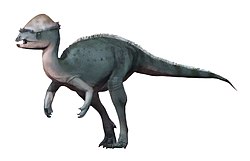 |
| Adelolophus | 2014 | Wahweap Formation (Late Cretaceous, Campanian) |  United States United States
( Utah) Utah) | Potentially a close relative of Parasaurolophus [5] |  |
| Agujaceratops | 2006 | Aguja Formation (Late Cretaceous, Campanian) |  United States United States
( Texas) Texas) | The type species was originally assigned to the genus Chasmosaurus | 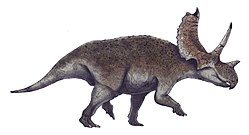 |
| Ahshislepelta | 2011 | Kirtland Formation (Late Cretaceous, Campanian) |  United States United States
( New Mexico) New Mexico) | Relatively small compared to other North American ankylosaurs |  |
| Ahshislesaurus | 2025 | Kirtland Formation (Late Cretaceous, Campanian) |  United States United States
( New Mexico) New Mexico) | The type specimen was originally considered to belong to Kritosaurus but it has been later found to be likely more closely related to Naashoibitosaurus |  |
| Ahvaytum | 2025 | Popo Agie Formation (Late Triassic, Carnian) |  United States United States
( Wyoming) Wyoming) | One of the oldest North American dinosaurs |  |
| Akainacephalus | 2018 | Kaiparowits Formation (Late Cretaceous, Campanian) |  United States United States
( Utah) Utah) | Much of the skeleton is known, including the entirety of the skull |  |
| Alamosaurus | 1922 | Ojo Alamo Formation (Late Cretaceous, Maastrichtian) |  United States United States
( New Mexico) New Mexico) | The first titanosaur confirmed to have crossed into North America, possibly representing a relative of South American forms [6] |  |
| Alaskacephale | 2006 | Prince Creek Formation (Late Cretaceous, Maastrichtian) |  United States United States
( Alaska) Alaska) | Had an array of polygonal nodes on its squamosal |  |
| Albertaceratops | 2007 | Oldman Formation (Late Cretaceous, Campanian) |  Canada Canada
( Alberta) Alberta) | Possessed long brow horns and a bony ridge over its nose | 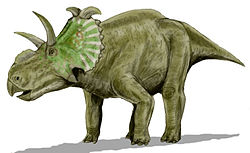 |
| Albertadromeus | 2013 | Oldman Formation (Late Cretaceous, Campanian) |  Canada Canada
( Alberta) Alberta) | The proportions of its hindlimb suggest a cursorial lifestyle |  |
| Albertavenator | 2017 | Horseshoe Canyon Formation (Late Cretaceous, Maastrichtian) |  Canada Canada
( Alberta) Alberta) | Its discovery suggests that the diversity of small dinosaurs may be higher than previously thought |  |
| Albertonykus | 2009 | Horseshoe Canyon Formation (Late Cretaceous, Maastrichtian) |  Canada Canada
( Alberta) Alberta) | May have used its specialized forelimbs to dig into tree trunks for feeding on termites [7] | 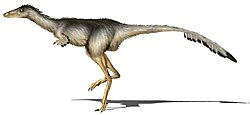 |
| Albertosaurus | 1905 | Horseshoe Canyon Formation (Late Cretaceous, Maastrichtian) |  Canada Canada
( Alberta) Alberta) | Known from more than thirty specimens, twenty-six of which are preserved together [8] |  |
| Aletopelta | 2001 | Point Loma Formation (Late Cretaceous, Campanian) |  United States United States
( California) California) | Would have lived in present-day Mexico. Its fossils were only found in California due to the shifting of tectonic plates |  |
| Allosaurus | 1877 | Morrison Formation (Late Jurassic, Kimmeridgian to Tithonian) |  United States United States
( Colorado Colorado
 Oklahoma Oklahoma
 Utah Utah
 Wyoming) Wyoming) | Multiple specimens have been discovered, making it well-known both popularly and scientifically. At least three species are known from the United States, in addition to one described from Portugal |  |
| Ampelognathus | 2023 | Lewisville Formation (Late Cretaceous, Cenomanian) |  United States United States
( Texas) Texas) | Originally described as a close relative of a clade containing Thescelosaurus and iguanodonts, [9] but it was recovered as a rhabdodontomorph by subsequent research [10] |  |
| Amphicoelias | 1878 | Morrison Formation (Late Jurassic, Tithonian) |  United States United States
( Colorado) Colorado) | Originally believed to date from the Cretaceous |  |
| Anasazisaurus | 1993 | Kirtland Formation (Late Cretaceous, Campanian) |  United States United States
( New Mexico) New Mexico) | May have been a second species of Kritosaurus [11] |  |
| Anchiceratops | 1914 | Horseshoe Canyon Formation (Late Cretaceous, Campanian) |  Canada Canada
( Alberta) Alberta) | Had a long, rectangular frill ringed by short, triangular spikes | 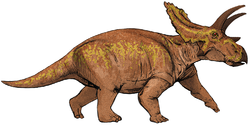 |
| Anchisaurus | 1885 | Portland Formation (Early Jurassic, Hettangian to Sinemurian) |  United States United States
( Connecticut Connecticut
 Massachusetts) Massachusetts) | Some possible remains were originally misidentified as human skeletons [12] |  |
| Angulomastacator | 2009 | Aguja Formation (Late Cretaceous, Campanian) |  United States United States
( Texas) Texas) | The tip of its jaw was angled 45° at its anterior end, with the tooth row bent to match |  |
| Animantarx | 1999 | Cedar Mountain Formation (Early Cretaceous to Late Cretaceous, Albian to Cenomanian) |  United States United States
( Utah) Utah) | Its holotype was discovered during a radiological survey of a fossil site. No bones were exposed before it was excavated |  |
| Ankylosaurus | 1908 | Ferris Formation, Frenchman Formation, Hell Creek Formation, Lance Formation, Scollard Formation (Late Cretaceous, Maastrichtian) |  Canada Canada
( Alberta Alberta
 Saskatchewan) Saskatchewan)
 United States United States
( Montana Montana
 Wyoming) Wyoming) | The largest and most well-known ankylosaur |  |
| Anodontosaurus | 1929 | Dinosaur Park Formation, Horseshoe Canyon Formation (Late Cretaceous, Campanian to Maastrichtian) |  Canada Canada
( Alberta) Alberta) | Originally mistakenly believed to have been toothless |  |
| Anzu | 2014 | Hell Creek Formation (Late Cretaceous, Maastrichtian) |  United States United States
( Montana Montana
 North Dakota North Dakota
 South Dakota) South Dakota) | Large and known from considerably good remains. Preserves evidence of a tall head crest |  |
| Apatoraptor | 2016 | Horseshoe Canyon Formation (Late Cretaceous, Campanian) |  Canada Canada
( Alberta) Alberta) | Quill knobs preserved on its ulna confirm this genus had wings |  |
| Apatosaurus | 1877 | Morrison Formation (Late Jurassic, Kimmeridgian to Tithonian) |  United States United States
( Colorado Colorado
 New Mexico New Mexico
 Oklahoma Oklahoma
 Utah Utah
 Wyoming) Wyoming) | Had a characteristically robust skeleton compared to other diplodocids | 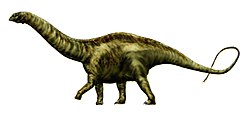 |
| Appalachiosaurus | 2005 | Blufftown Formation?, Demopolis Chalk, Donoho Creek Formation?, Ripley Formation?, Tar Heel/Coachman Formation? (Late Cretaceous, Campanian) |  United States United States
( Alabama Alabama
 Georgia (U.S. state)? Georgia (U.S. state)?
 North Carolina? North Carolina?
 South Carolina?) South Carolina?) | The most complete theropod known from the eastern side of North America |  |
| Aquilarhinus | 2019 | Aguja Formation (Late Cretaceous, Campanian) |  United States United States
( Texas) Texas) | May have been a semiaquatic, coastal species that used its unusual, shovel-shaped bill to scoop up vegetation in wet sediment [13] |  |
| Aquilops | 2014 | Cloverly Formation (Early Cretaceous, Albian) |  United States United States
( Montana) Montana) | May have had a short horn protruding from its upper beak |  |
| Ardetosaurus | 2024 | Morrison Formation (Late Jurassic, Kimmeridgian) |  United States United States
( Wyoming) Wyoming) | The holotype specimen was damaged by a museum fire |  |
| Arkansaurus | 2018 | Trinity Group (Early Cretaceous, Aptian to Albian) |  United States United States
( Arkansas) Arkansas) | State dinosaur of Arkansas. Its generic name was in use informally even before its formal description |  |
| Arrhinoceratops | 1925 | Horseshoe Canyon Formation (Late Cretaceous, Campanian to Maastrichtian) |  Canada Canada
( Alberta) Alberta) | Described as lacking a nasal horn although this is an artifact of preservation |  |
| Astrodon | 1865 | Antlers Formation?, Arundel Formation (Early Cretaceous, Albian) |  United States United States
( Maryland Maryland
 Oklahoma?) Oklahoma?) | State dinosaur of Maryland |  |
| Astrophocaudia | 2012 | Paluxy Formation (Early Cretaceous, Albian) |  United States United States
( Texas) Texas) | Known from a single partial skeleton |  |
| Athenar | 2025 | Morrison Formation (Late Jurassic, Tithonian) |  United States United States
( Utah) Utah) | Originally believed to be a diplodocid |  |
| Atlantosaurus | 1877 | Morrison Formation (Late Jurassic, Kimmeridgian) |  United States United States
( Colorado) Colorado) | Potentially synonymous with Apatosaurus, [14] but a referred species may represent a separate taxon [15] |  |
| Atrociraptor | 2004 | Horseshoe Canyon Formation (Late Cretaceous, Maastrichtian) |  Canada Canada
( Alberta) Alberta) | Had a short, deep snout with enlarged teeth |  |
| Aublysodon | 1868 | Judith River Formation (Late Cretaceous, Campanian) |  United States United States
( Montana) Montana) | Only known from teeth |  |
| Augustynolophus | 2014 | Moreno Formation (Late Cretaceous, Maastrichtian) |  United States United States
( California) California) | State dinosaur of California. Originally named as a species of Saurolophus |  |
| Avaceratops | 1986 | Judith River Formation (Late Cretaceous, Campanian) |  United States United States
( Montana) Montana) | Lacked the fenestrae in its frill, a feature shared only with Triceratops |  |
| Bambiraptor | 2000 | Two Medicine Formation (Late Cretaceous, Campanian) |  United States United States
( Montana) Montana) | Small but well-preserved enough to display its mix of dinosaur- and bird-like features |  |
| Barosaurus | 1890 | Morrison Formation (Late Jurassic, Kimmeridgian to Tithonian) |  United States United States
( South Dakota South Dakota
 Utah) Utah) | Similar to Diplodocus but larger and with a longer neck |  |
| Bistahieversor | 2010 | Fruitland Formation, Kirtland Formation (Late Cretaceous, Campanian) |  United States United States
( New Mexico) New Mexico) | Analysis of its braincase suggests it behaved like tyrannosaurids despite likely not being a member of that family [16] |  |
| Bisticeratops | 2022 | Kirtland Formation (Late Cretaceous, Campanian) |  United States United States
( New Mexico) New Mexico) | Preserves bite marks from a tyrannosaurid |  |
| Borealopelta | 2017 | Clearwater Formation (Early Cretaceous, Albian) |  Canada Canada
( Alberta) Alberta) | So well-preserved that several osteoderms, keratin, pigments and stomach contents are preserved in the positions they would have been in while alive, without flattening or shriveling |  |
| Boreonykus | 2015 | Wapiti Formation (Late Cretaceous, Campanian) |  Canada Canada
( Alberta) Alberta) | One of the few dromaeosaurids known from high latitudes |  |
| Brachiosaurus | 1903 | Morrison Formation (Late Jurassic, Kimmeridgian to Tithonian) |  United States United States
( Colorado Colorado
 Oklahoma Oklahoma
 Utah Utah
 Wyoming) Wyoming) | A high browser with a tall chest and elongated forelimbs |  |
| Brachyceratops | 1914 | Two Medicine Formation (Late Cretaceous, Campanian) |  United States United States
( Montana) Montana) | Only known from juvenile remains. One specimen has been found to represent a subadult Styracosaurus ovatus |  |
| Brachylophosaurus | 1953 | Judith River Formation, Oldman Formation, Wahweap Formation? (Late Cretaceous, Campanian) |  Canada Canada
( Alberta) Alberta)
 United States United States
( Montana Montana
 Utah?) Utah?) | Several specimens preserve extensive soft tissue remains |  |
| Bravoceratops | 2013 | Javelina Formation (Late Cretaceous, Campanian to Maastrichtian) |  United States United States
( Texas) Texas) | Suggested to have had a single small horn on the top of its frill but this may be inaccurate |  |
| Brontomerus | 2011 | Cedar Mountain Formation (Early Cretaceous, Aptian to Albian) |  United States United States
( Utah) Utah) | Possessed an enlarged ilium which supported powerful leg muscles, which it may have used to kick away predators |  |
| Brontosaurus | 1879 | Morrison Formation (Late Jurassic, Kimmeridgian to Tithonian) |  United States United States
( Utah Utah
 Wyoming) Wyoming) | Popularly associated with Apatosaurus but a 2015 study found enough differences for it to be classified as a separate genus [15] |  |
| Brontotholus | 2025 | Oldman Formation, Two Medicine Formation (Late Cretaceous, Campanian) |  Canada Canada
( Alberta) Alberta)
 United States United States
( Montana) Montana) | One of the largest known North American pachycephalosaurs |  |
| Caenagnathus | 1940 | Dinosaur Park Formation (Late Cretaceous, Campanian) |  Canada Canada
( Alberta) Alberta) | One of the largest known caenagnathids [17] |  |
| Camarasaurus | 1877 | Morrison Formation, Summerville Formation? (Late Jurassic, Kimmeridgian to Tithonian) |  United States United States
( Colorado Colorado
 New Mexico? New Mexico?
 Oklahoma? Oklahoma?
 South Dakota? South Dakota?
 Utah Utah
 Wyoming) Wyoming) | Very common and known from multiple specimens |  |
| Camposaurus | 1998 | Bluewater Creek Formation (Late Triassic, Norian) |  United States United States
( Arizona) Arizona) | Potentially the oldest known neotheropod |  |
| Camptosaurus | 1885 | Morrison Formation (Late Jurassic, Kimmeridgian to Tithonian) |  United States United States
( Utah Utah
 Wyoming) Wyoming) | May have fed on tough vegetation as evidenced by extensive wear frequently exhibited on its teeth [18] |  |
| Caseosaurus | 1998 | Tecovas Formation (Late Triassic, Norian) |  United States United States
( Texas) Texas) | Possibly synonymous with Chindesaurus |  |
| Cedarosaurus | 1999 | Cedar Mountain Formation (Early Cretaceous, Valanginian) |  United States United States
( Utah) Utah) | One specimen preserves over a hundred gastroliths [19] | 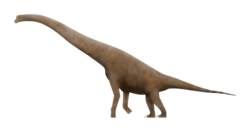 |
| Cedarpelta | 2001 | Cedar Mountain Formation (Late Cretaceous, Cenomanian to Turonian) |  United States United States
( Utah) Utah) | Lacked the extensive cranial ornamentation of later ankylosaurids |  |
| Cedrorestes | 2007 | Cedar Mountain Formation (Early Cretaceous, Valanginian) |  United States United States
( Utah) Utah) | Known from a partial skeleton. The specific name, crichtoni, honors Michael Crichton, author of Jurassic Park and The Lost World |  |
| Centrosaurus | 1904 | Dinosaur Park Formation (Late Cretaceous, Campanian) |  Canada Canada
( Alberta) Alberta) | Hundreds of individuals have been preserved in a single "mega-bonebed" [20] |  |
| Cerasinops | 2007 | Two Medicine Formation (Late Cretaceous, Campanian) |  United States United States
( Montana) Montana) | Combines features of both Asian and North American basal ceratopsians |  |
| Ceratops | 1888 | Judith River Formation (Late Cretaceous, Campanian) |  United States United States
( Montana) Montana) | Although only known from a few bones, this genus is the namesake of the Ceratopsia and the Ceratopsidae |  |
| Ceratosaurus | 1884 | Morrison Formation (Late Jurassic, Kimmeridgian to Tithonian) |  United States United States
( Colorado Colorado
 Utah Utah
 Wyoming) Wyoming) | Possessed a row of osteoderms running down its back |  |
| Chasmosaurus | 1914 | Dinosaur Park Formation (Late Cretaceous, Campanian) |  Canada Canada
( Alberta) Alberta) | Known from multiple remains, including various skulls | 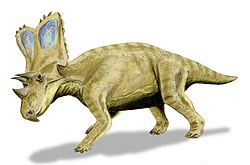 |
| Chindesaurus | 1995 | Chinle Formation (Late Triassic, Norian) |  United States United States
( Arizona) Arizona) | May be a herrerasaur or a close relative of Tawa [21] |  |
| Chirostenotes | 1924 | Dinosaur Park Formation (Late Cretaceous, Campanian) |  Canada Canada
( Alberta) Alberta) | Originally known only from isolated body parts |  |
| Cionodon | 1874 | Denver Formation, Judith River Formation (Late Cretaceous, Campanian to Maastrichtian) |  Canada Canada
( Alberta) Alberta)
 United States United States
( Colorado) Colorado) | Poorly known |  |
| Citipes | 2020 | Dinosaur Park Formation (Late Cretaceous, Campanian) |  Canada Canada
( Alberta) Alberta) | Some specimens were found as stomach contents of Gorgosaurus [22] |  |
| Claosaurus | 1890 | Niobrara Formation (Late Cretaceous, Santonian to Campanian) |  United States United States
( Kansas) Kansas) | Historically conflated with other hadrosaurs | 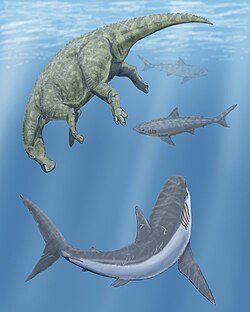 |
| Coahuilaceratops | 2010 | Cerro Huerta Formation (Late Cretaceous, Maastrichtian) |  Mexico Mexico
( Coahuila) Coahuila) | Possessed brow horns comparable in size to those of Triceratops and Torosaurus |  |
| Coahuilasaurus | 2024 | Cerro del Pueblo Formation (Late Cretaceous, Campanian) |  Mexico Mexico
( Coahuila) Coahuila) | Identified as a specimen of Kritosaurus [23] before receiving its own genus name [24] |  |
| Coelophysis | 1889 | Chinle Formation (Late Triassic, Norian) |  United States United States
( Arizona Arizona
 New Mexico) New Mexico) | Known from over a thousand specimens, making it one of the most well-known early dinosaurs. Some referred species may belong to their own genera |  |
| Coelurus | 1879 | Morrison Formation (Late Jurassic, Kimmeridgian) |  United States United States
( Wyoming) Wyoming) | Potentially an early member of the tyrannosauroid lineage [25] |  |
| Colepiocephale | 2003 | Foremost Formation (Late Cretaceous, Campanian) |  Canada Canada
( Alberta) Alberta) | Originally described as a species of Stegoceras |  |
| Convolosaurus | 2019 | Twin Mountains Formation (Early Cretaceous, Aptian) |  United States United States
( Texas) Texas) | Before its formal description, it had been informally referred to as the "Proctor Lake hypsilophodontid" |  |
| Coronosaurus | 2012 | Oldman Formation (Late Cretaceous, Campanian) |  Canada Canada
( Alberta) Alberta) | Had irregular masses of small spikes on the very top of its frill |  |
| Corythosaurus | 1914 | Dinosaur Park Formation, Oldman Formation (Late Cretaceous, Campanian) |  Canada Canada
( Alberta) Alberta) | Possessed a semicircular crest which may have been used for vocalization |  |
| Crittendenceratops | 2018 | Fort Crittenden Formation (Late Cretaceous, Campanian) |  United States United States
( Arizona) Arizona) | The youngest known member of the Nasutoceratopsini |  |
| Daemonosaurus | 2011 | Chinle Formation (Late Triassic, Norian to Rhaetian?) |  United States United States
( New Mexico) New Mexico) | Unique among early dinosaurs for possessing a short snout with long teeth |  |
| Dakotadon | 2008 | Lakota Formation (Early Cretaceous, Valanginian to Barremian) |  United States United States
( South Dakota) South Dakota) | Originally named as a species of Iguanodon |  |
| Dakotaraptor | 2015 | Hell Creek Formation (Late Cretaceous, Maastrichtian) |  United States United States
( South Dakota) South Dakota) | The holotype assemblage may represent a chimera of multiple taxa [26] |  |
| Daspletosaurus | 1970 | Dinosaur Park Formation, Judith River Formation, Oldman Formation, Two Medicine Formation (Late Cretaceous, Campanian) |  Canada Canada
( Alberta) Alberta)
 United States United States
( Montana) Montana) | At least three species are known. These have been interpreted as forming an anagenetic lineage [27] but this hypothesis has been criticized [28] |  |
| Deinonychus | 1969 | Antlers Formation, Arundel Formation?, Cedar Mountain Formation?, Cloverly Formation (Early Cretaceous to Late Cretaceous, Aptian to Cenomanian) |  United States United States
( Maryland? Maryland?
 Montana Montana
 Oklahoma Oklahoma
 Utah? Utah?
 Wyoming) Wyoming) | Its discovery helped researchers realize that dinosaurs were active, warm-blooded animals, kicking off the Dinosaur Renaissance | 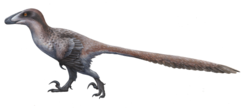 |
| Denversaurus | 1988 | Hell Creek Formation, Lance Formation (Late Cretaceous, Maastrichtian) |  United States United States
( South Dakota South Dakota
 Wyoming) Wyoming) | The youngest known nodosaurid [29] |  |
| Diabloceratops | 2010 | Wahweap Formation (Late Cretaceous, Campanian) |  United States United States
( Utah) Utah) | Had a distinctively short, deep skull |  |
| Diclonius | 1876 | Judith River Formation (Late Cretaceous, Campanian) |  United States United States
( Montana) Montana) | Replaced its teeth in such a way that new teeth could be used at the same time as older ones | |
| Dilophosaurus | 1970 | Kayenta Formation (Early Jurassic, Sinemurian to Toarcian) |  United States United States
( Arizona) Arizona) | Possessed two semicircular crests running along the length of the skull |  |
| Dineobellator | 2020 | Ojo Alamo Formation (Late Cretaceous, Maastrichtian) |  United States United States
( New Mexico) New Mexico) | Several features of its hands and feet may be adaptations for increased grip strength [30] |  |
| Diplodocus | 1878 | Morrison Formation (Late Jurassic, Kimmeridgian to Tithonian?) |  United States United States
( Colorado Colorado
 Montana Montana
 New Mexico New Mexico
 Utah Utah
 Wyoming) Wyoming) | Had a long, thin tail popularly thought to have been used like a bullwhip [31] but it is possible that it could not handle the stress of supersonic travel [32] | 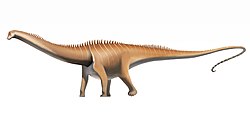 |
| Diplotomodon | 1868 | Hornerstown Formation?/Navesink Formation? (Late Cretaceous, Maastrichtian) |  United States United States
( New Jersey) New Jersey) | Has been suggested to be non-dinosaurian |  |
| Dromaeosaurus | 1922 | Dinosaur Park Formation, Hell Creek Formation?, Horseshoe Canyon Formation?, Prince Creek Formation? (Late Cretaceous, Campanian to Maastrichtian?) |  Canada Canada
( Alberta) Alberta)
 United States United States
( Alaska? Alaska?
 South Dakota?) South Dakota?) | Analysis of wear on its teeth suggests it preferred tougher prey, including bone |  |
| Dromiceiomimus | 1972 | Horseshoe Canyon Formation (Late Cretaceous, Maastrichtian) |  Canada Canada
( Alberta) Alberta) | May be synonymous with Ornithomimus edmontonicus |  |
| Dryosaurus | 1894 | Morrison Formation (Late Jurassic, Kimmeridgian to Tithonian) |  United States United States
( Colorado Colorado
 Utah Utah
 Wyoming) Wyoming) | Remains of multiple growth stages have been found, including specimens in embryonic age [33] |  |
| Dryptosaurus | 1877 | Navesink Formation?, New Egypt Formation (Late Cretaceous, Maastrichtian) |  United States United States
( New Jersey) New Jersey) | Its discovery showed that theropods were bipedal animals |  |
| Dynamoterror | 2018 | Menefee Formation (Late Cretaceous, Campanian) |  United States United States
( New Mexico) New Mexico) | Part of the Teratophoneini, a clade of tyrannosaurids exclusively known from southwestern North America [28] |  |
| Dyoplosaurus | 1924 | Dinosaur Park Formation (Late Cretaceous, Campanian) |  Canada Canada
( Alberta) Alberta) | The holotype specimen preserves skin impressions [34] |  |
| Dysganus | 1876 | Judith River Formation (Late Cretaceous, Campanian) |  United States United States
( Montana) Montana) | Four species have been named, all from isolated teeth | |
| Dyslocosaurus | 1992 | Lance Formation?/Morrison Formation? (Late Jurassic, Kimmeridgian?/Late Cretaceous, Maastrichtian?) |  United States United States
( Wyoming) Wyoming) | Has been suggested to have four claws on its hindlimbs |  |
| Dystrophaeus | 1877 | Morrison Formation (Late Jurassic, Oxfordian) |  United States United States
( Utah) Utah) | Inconsistent in phylogenetic placement, although undescribed remains could further clarify its relationships |  |
| Edmontonia | 1928 | Dinosaur Park Formation, Horseshoe Canyon Formation, Judith River Formation? (Late Cretaceous, Campanian to Maastrichtian) |  Canada Canada
( Alberta) Alberta)
 United States United States
( Montana?) Montana?) | Possessed forward-pointing, bifurcated spikes on its shoulders |  |
| Edmontosaurus | 1917 | Frenchman Formation, Hell Creek Formation, Horseshoe Canyon Formation, Lance Formation, Prince Creek Formation (Late Cretaceous, Campanian to Maastrichtian) |  Canada Canada
( Alberta Alberta
 Saskatchewan) Saskatchewan)
 United States United States
( Alaska Alaska
 Colorado Colorado
 Montana Montana
 North Dakota North Dakota
 South Dakota South Dakota
 Wyoming) Wyoming) | Known from multiple well-preserved specimens, including a few "mummies". Several were originally assigned to their own genera and/or species |  |
| Einiosaurus | 1994 | Two Medicine Formation (Late Cretaceous, Campanian) |  United States United States
( Montana) Montana) | Distinguished by its forward-curving nasal horn |  |
| Enigmacursor | 2025 | Morrison Formation (Late Jurassic, Kimmeridgian to Tithonian) |  United States United States
( Colorado) Colorado) | Known from a three-dimensionally preserved skeleton [35] |  |
| Eolambia | 1998 | Cedar Mountain Formation (Late Cretaceous, Cenomanian) |  United States United States
( Utah) Utah) | Remains of multiple individuals are known, making up much of the skeleton |  |
| Eoneophron | 2024 | Hell Creek Formation (Late Cretaceous, Maastrichtian) |  United States United States
( South Dakota) South Dakota) | Smaller than the contemporary Anzu |  |
| Eotrachodon | 2016 | Mooreville Chalk (Late Cretaceous, Santonian) |  United States United States
( Alabama) Alabama) | Had a saurolophine-like skull despite its basal position [36] |  |
| Eotriceratops | 2007 | Horseshoe Canyon Formation (Late Cretaceous, Maastrichtian) |  Canada Canada
( Alberta) Alberta) | May have been the largest known ceratopsid |  |
| Epichirostenotes | 2011 | Horseshoe Canyon Formation (Late Cretaceous, Maastrichtian) |  Canada Canada
( Alberta) Alberta) | Its discovery allowed researchers to connect isolated caenagnathid body parts to each other |  |
| Euoplocephalus | 1910 | Dinosaur Park Formation (Late Cretaceous, Campanian) |  Canada Canada
( Alberta) Alberta) | Unusually, its palpebral bone was mobile, allowing it to be used as an eyelid [37] |  |
| Falcarius | 2005 | Cedar Mountain Formation (Early Cretaceous, Valanginian) |  United States United States
( Utah) Utah) | Transitional between generalized theropods and specialized therizinosaurs |  |
| Ferrisaurus | 2019 | Tango Creek Formation (Late Cretaceous, Maastrichtian) |  Canada Canada
( British Columbia) British Columbia) | Its holotype was discovered close to a railway line [38] |  |
| Fona | 2024 | Cedar Mountain Formation (Late Cretaceous, Cenomanian) |  United States United States
( Utah) Utah) | Possibly a semi-fossorial animal based on the related Oryctodromeus [39] |  |
| Foraminacephale | 2016 | Dinosaur Park Formation, Oldman Formation (Late Cretaceous, Campanian) |  Canada Canada
( Alberta) Alberta) | Originally assigned to three different pachycephalosaurid genera |  |
| Fosterovenator | 2014 | Morrison Formation (Late Jurassic, Kimmeridgian to Tithonian) |  United States United States
( Wyoming) Wyoming) | Has been variously described as a ceratosaurid, a tetanuran or a close relative of Elaphrosaurus [40] |  |
| Fruitadens | 2010 | Morrison Formation (Late Jurassic, Tithonian) |  United States United States
( Colorado) Colorado) | One of the smallest known ornithischians [41] |  |
| Furcatoceratops | 2023 | Judith River Formation (Late Cretaceous, Campanian) |  United States United States
( Montana) Montana) | Preserves most of the postcranial skeleton, a rarity for ceratopsids. Remains originally identified as Avaceratops |  |
| Galeamopus | 2015 | Morrison Formation (Late Jurassic, Kimmeridgian) |  United States United States
( Colorado Colorado
 Wyoming) Wyoming) | One specimen is nearly complete, even preserving an associated skull |  |
| Gargoyleosaurus | 1998 | Morrison Formation (Late Jurassic, Kimmeridgian to Tithonian) |  United States United States
( Wyoming) Wyoming) | Combines features of both ankylosaurids and nodosaurids |  |
| Gastonia | 1998 | Cedar Mountain Formation (Early Cretaceous, Valanginian to Barremian) |  United States United States
( Utah) Utah) | Several concentrations of fossils may suggest this taxon lived in herds [42] |  |
| Geminiraptor | 2010 | Cedar Mountain Formation (Early Cretaceous, Valanginian) |  United States United States
( Utah) Utah) | The proportions of its maxilla are similar to those of Late Cretaceous troodontids |  |
| Glishades | 2010 | Two Medicine Formation (Late Cretaceous, Campanian) |  United States United States
( Montana) Montana) | Described as a basal hadrosauroid but may in fact be a juvenile saurolophine hadrosaurid [43] | |
| Glyptodontopelta | 2000 | Ojo Alamo Formation (Late Cretaceous, Maastrichtian) |  United States United States
( New Mexico) New Mexico) | Originally interpreted as possessing a flat mosaic of osteoderms similar to the shields of glyptodonts |  |
| Gojirasaurus | 1997 | Bull Canyon Formation (Late Triassic, Norian) |  United States United States
( New Mexico) New Mexico) | May be a chimera consisting of undiagnostic theropod bones mixed with pseudosuchian vertebrae [44] | 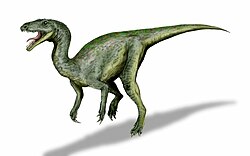 |
| Gorgosaurus | 1914 | Dinosaur Park Formation, Judith River Formation?, Two Medicine Formation? (Late Cretaceous, Campanian) |  Canada Canada
( Alberta) Alberta)
 United States United States
( Montana?) Montana?) | Dozens of specimens are known |  |
| Gravitholus | 1979 | Dinosaur Park Formation (Late Cretaceous, Campanian) |  Canada Canada
( Alberta) Alberta) | Potentially synonymous with Stegoceras [45] |  |
| Gremlin | 2023 | Oldman Formation (Late Cretaceous, Campanian) |  Canada Canada
( Alberta) Alberta) | Possessed a ridge running along the top of the skull |  |
| Gryphoceratops | 2012 | Milk River Formation (Late Cretaceous, Santonian) |  Canada Canada
( Alberta) Alberta) | Potentially the smallest adult ceratopsian known from North America |  |
| Gryposaurus | 1914 | Bearpaw Formation?, Dinosaur Park Formation, Javelina Formation?, Kaiparowits Formation, Two Medicine Formation (Late Cretaceous, Santonian to Maastrichtian?) |  Canada Canada
( Alberta) Alberta)
 United States United States
( Montana Montana
 Texas? Texas?
 Utah) Utah) | One specimen preserves impressions of a row of pyramidal scales running along its back [46] |  |
| Hadrosaurus | 1858 | Woodbury Formation (Late Cretaceous, Campanian) |  United States United States
( New Jersey) New Jersey) | Its holotype was the first dinosaur skeleton to be mounted |  |
| Hagryphus | 2005 | Kaiparowits Formation (Late Cretaceous, Campanian) |  United States United States
( Utah) Utah) | Large but only known from a single hand |  |
| Hanssuesia | 2003 | Dinosaur Park Formation, Judith River Formation, Oldman Formation (Late Cretaceous, Campanian) |  Canada Canada
( Alberta) Alberta)
 United States United States
( Montana) Montana) | One dome preserves several lesions |  |
| Haplocanthosaurus | 1903 | Morrison Formation (Late Jurassic, Kimmeridgian) |  United States United States
( Colorado Colorado
 Montana? Montana?
 Wyoming) Wyoming) | One of the smallest sauropods of the Morrison Formation |  |
| Hesperonychus | 2009 | Dinosaur Park Formation, Oldman Formation? (Late Cretaceous, Campanian) |  Canada Canada
( Alberta) Alberta) | A common component of its habitat as indicated by the great number of its remains |  |
| Hesperornithoides | 2019 | Morrison Formation (Late Jurassic, Oxfordian to Tithonian) |  United States United States
( Wyoming) Wyoming) | Before its formal description, it had been nicknamed "Lori" |  |
| Hesperosaurus | 2001 | Morrison Formation (Late Jurassic, Kimmeridgian) |  United States United States
( Montana Montana
 Wyoming) Wyoming) | Two morphotypes of plates are known, which has been interpreted as an indication of sexual dimorphism [47] |  |
| Hierosaurus | 1909 | Niobrara Formation (Late Cretaceous, Coniacian to Campanian) |  United States United States
( Kansas) Kansas) | Only known from a few bones, including osteoderms |  |
| Hippodraco | 2010 | Cedar Mountain Formation (Early Cretaceous, Valanginian) |  United States United States
( Utah) Utah) | Its tooth crowns were shaped like shields |  |
| Hoplitosaurus | 1902 | Lakota Formation (Early Cretaceous, Barremian?) |  United States United States
( South Dakota) South Dakota) | Known from some osteoderms, including spikes similar to those of Polacanthus |  |
| Huehuecanauhtlus | 2012 | Unnamed formation (Late Cretaceous, Santonian) |  Mexico Mexico
( Michoacán) Michoacán) | The southernmost non-hadrosaurid hadrosauroid known from North America [48] | 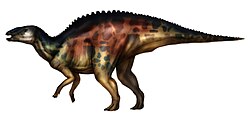 |
| Hypacrosaurus | 1913 | Horseshoe Canyon Formation, Two Medicine Formation (Late Cretaceous, Campanian to Maastrichtian) |  Canada Canada
( Alberta) Alberta)
 United States United States
( Montana) Montana) | Some juveniles of this genus were originally interpreted as dwarf lambeosaurines |  |
| Hypsibema | 1869 | Marshalltown Formation?, Ripley Formation, Tar Heel/Coachman Formation (Late Cretaceous, Campanian) |  United States United States
( Missouri Missouri
 New Jersey? New Jersey?
 North Carolina) North Carolina) | Potentially one of the largest non-hadrosaurid hadrosauroids |  |
| Hypsirhophus | 1878 | Morrison Formation (Late Jurassic, Tithonian) |  United States United States
( Colorado) Colorado) | Usually seen as synonymous with Stegosaurus but may be a separate genus due to differences in its vertebrae [49] |  |
| Iani | 2023 | Cedar Mountain Formation (Late Cretaceous, Cenomanian) |  United States United States
( Utah) Utah) | Represents the family Tenontosauridae, a clade of North American rhabdodontomorphs [50] |  |
| Iguanacolossus | 2010 | Cedar Mountain Formation (Early Cretaceous, Valanginian) |  United States United States
( Utah) Utah) | Large and robustly built |  |
| Invictarx | 2018 | Menefee Formation (Late Cretaceous, Campanian) |  United States United States
( New Mexico) New Mexico) | Only known from a few bones but can be distinguished from other genera by characters of its osteoderms |  |
| Issi | 2021 | Fleming Fjord Formation (Late Triassic, Norian) |  Greenland Greenland
(Sermersooq) | Originally described as an exemplar of Plateosaurus |  |
| Jeyawati | 2010 | Moreno Hill Formation (Late Cretaceous, Turonian to Coniacian) |  United States United States
( New Mexico) New Mexico) | Its postorbital bone had a rugose texture |  |
| Judiceratops | 2013 | Judith River Formation (Late Cretaceous, Campanian) |  United States United States
( Montana) Montana) | Unusually, its brow horns were teardrop-shaped in cross-section |  |
| Kaatedocus | 2012 | Morrison Formation (Late Jurassic, Kimmeridgian) |  United States United States
( Wyoming) Wyoming) | Originally interpreted as a diplodocid although one study finds it to be more likely a basal dicraeosaurid [51] |  |
| Kayentavenator | 2010 | Kayenta Formation (Early Jurassic, Sinemurian to Pliensbachian) |  United States United States
( Arizona) Arizona) | Described in a book published through an online print-on-demand service |  |
| Koparion | 1994 | Morrison Formation (Late Jurassic, Kimmeridgian) |  United States United States
( Utah) Utah) | Known from a single tooth which may have come from a troodontid |  |
| Kosmoceratops | 2010 | Kaiparowits Formation (Late Cretaceous, Campanian) |  United States United States
( Utah) Utah) | Possessed fifteen horns and horn-like structures, including eight hornlets folding down from the top of the frill |  |
| Kritosaurus | 1910 | El Picacho Formation?, Javelina Formation?, Kirtland Formation, Ojo Alamo Formation? (Late Cretaceous, Campanian to Maastrichtian?) |  United States United States
( New Mexico New Mexico
 Texas?) Texas?) | Had an elevated nasal bone with an enlarged nasal cavity to match |  |
| Labocania | 1974 | Cerro del Pueblo Formation, La Bocana Roja Formation (Late Cretaceous, Cenomanian? to Campanian) |  Mexico Mexico
( Baja California Baja California
 Coahuila) Coahuila) | The description of the second species, L. aguillonae, suggests a position within the tyrannosaurid clade Teratophoneini [52] |  |
| Lambeosaurus | 1923 | Dinosaur Park Formation (Late Cretaceous, Campanian) |  Canada Canada
( Alberta) Alberta) | Possessed a hollow head crest that varied in shape between species, sexes and ages. Most familiarly, it was hatchet-shaped in adult male L. lambei |  |
| Laosaurus | 1878 | Morrison Formation (Late Jurassic, Oxfordian to Tithonian) |  United States United States
( Wyoming) Wyoming) | Several referred specimens have been reassigned to other taxa |  |
| Latirhinus | 2012 | Cerro del Pueblo Formation (Late Cretaceous, Campanian) |  Mexico Mexico
( Coahuila) Coahuila) | As described, it represented a chimera composed of lambeosaurine and saurolophine remains. [53] The exact holotypic bones belonged to a lambeosaurine [54] |  |
| Lepidus | 2015 | Colorado City Formation (Late Triassic, Norian) |  United States United States
( Texas) Texas) | Muscle scars are preserved on the holotype bones |  |
| Leptoceratops | 1914 | Hell Creek Formation, Lance Formation, Scollard Formation (Late Cretaceous, Maastrichtian) |  Canada Canada
( Alberta) Alberta)
 United States United States
( Montana Montana
 Wyoming) Wyoming) | Analysis of its teeth shows it could chew like a mammal, an adaptation to eating tough, fibrous plants [55] |  |
| Leptorhynchos | 2013 | Aguja Formation (Late Cretaceous, Campanian) |  United States United States
( Texas) Texas) | Had a slightly upturned mandible similar to those of oviraptorids | 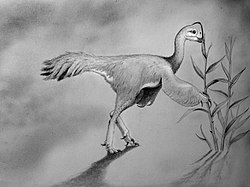 |
| Lokiceratops | 2024 | Judith River Formation (Late Cretaceous, Campanian) |  United States United States
( Montana) Montana) | Unusually for a ceratopsid, its frill ornamentations were bilaterally asymmetrical. Closely related to Albertaceratops and Medusaceratops [56] |  |
| Lophorhothon | 1960 | Mooreville Chalk, Tar Heel/Coachman Formation? (Late Cretaceous, Campanian) |  United States United States
( Alabama Alabama
 North Carolina?) North Carolina?) | Although incomplete, the holotype skull preserves evidence of a crest |  |
| Lythronax | 2013 | Wahweap Formation (Late Cretaceous, Campanian) |  United States United States
( Utah) Utah) | Already had the forward-directed orbits of derived tyrannosaurids despite its early age |  |
| Machairoceratops | 2016 | Wahweap Formation (Late Cretaceous, Campanian) |  United States United States
( Utah) Utah) | Possessed two long, forward-pointing horns on the top of its frill |  |
| Magnapaulia | 2012 | El Gallo Formation (Late Cretaceous, Campanian) |  Mexico Mexico
( Baja California) Baja California) | Has been suggested to be semi-aquatic due to its tall, narrow tail [57] |  |
| Maiasaura | 1979 | Oldman Formation, Two Medicine Formation (Late Cretaceous, Campanian) |  Canada Canada
( Alberta) Alberta)
 United States United States
( Montana) Montana) | Remains of hundreds of individuals, including juveniles, eggs and nests, have been found at a single site [58] | 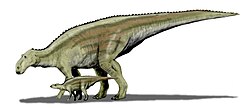 |
| Malefica | 2022 | Aguja Formation (Late Cretaceous, Campanian) |  United States United States
( Texas) Texas) | Its discovery suggests a greater diversity of basal hadrosaurids than previously thought |  |
| Maraapunisaurus | 2018 | Morrison Formation (Late Jurassic, Kimmeridgian) |  United States United States
( Colorado) Colorado) | Named from a single, lost vertebra of immense size |  |
| Marshosaurus | 1976 | Morrison Formation (Late Jurassic, Kimmeridgian) |  United States United States
( Colorado? Colorado?
 Utah) Utah) | Potentially a close relative of Piatnitzkysaurus and Condorraptor [59] |  |
| Martharaptor | 2012 | Cedar Mountain Formation (Early Cretaceous, Valanginian) |  United States United States
( Utah) Utah) | Had not yet acquired the robust feet of derived therizinosaurs |  |
| Medusaceratops | 2010 | Judith River Formation (Late Cretaceous, Campanian) |  United States United States
( Montana) Montana) | Possessed elongated spikes curving away from the sides of its frill |  |
| Menefeeceratops | 2021 | Menefee Formation (Late Cretaceous, Campanian) |  United States United States
( New Mexico) New Mexico) | One of the oldest centrosaurines |  |
| Mercuriceratops | 2014 | Dinosaur Park Formation, Judith River Formation (Late Cretaceous, Campanian) |  Canada Canada
( Alberta) Alberta)
 United States United States
( Montana) Montana) | Had "wing"-like projections on its squamosal bones |  |
| Mexidracon | 2025 | Cerro del Pueblo Formation (Late Cretaceous, Campanian) |  Mexico Mexico
( Coahuila) Coahuila) | Had unusually long hands for an ornithomimosaur |  |
| Microvenator | 1970 | Cloverly Formation (Early Cretaceous, Albian) |  United States United States
( Montana) Montana) | Teeth from Deinonychus have been mistakenly attributed to this genus | 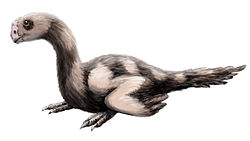 |
| Mierasaurus | 2017 | Cedar Mountain Formation (Early Cretaceous, Valanginian) |  United States United States
( Utah) Utah) | One of the latest-surviving turiasaurs [60] |  |
| Moabosaurus | 2017 | Cedar Mountain Formation (Early Cretaceous, Aptian) |  United States United States
( Utah) Utah) | Described as a macronarian [61] but has since been reinterpreted as a turiasaur closely related to Mierasaurus [60] |  |
| Monoclonius | 1876 | Dinosaur Park Formation, Judith River Formation (Late Cretaceous, Campanian) |  Canada Canada
( Alberta) Alberta)
 United States United States
( Montana) Montana) | Only known from indistinct remains of juveniles and subadults |  |
| Montanoceratops | 1951 | Horseshoe Canyon Formation?, St. Mary River Formation (Late Cretaceous, Maastrichtian) |  Canada Canada
( Alberta) Alberta)
 United States United States
( Montana) Montana) | Often restored with a short nasal horn although this may be a misplaced cheek horn [62] |  |
| Moros | 2019 | Cedar Mountain Formation (Late Cretaceous, Cenomanian) |  United States United States
( Utah) Utah) | The proportions of its metatarsals are similar to those of ornithomimids |  |
| Mymoorapelta | 1994 | Morrison Formation (Late Jurassic, Kimmeridgian to Tithonian) |  United States United States
( Colorado Colorado
 Utah) Utah) | The first ankylosaur described from the Morrison Formation |  |
| Naashoibitosaurus | 1993 | Kirtland Formation (Late Cretaceous, Campanian) |  United States United States
( New Mexico) New Mexico) | Like other kritosaurins, it possessed a nasal arch, but it was not as tall as that of Gryposaurus |  |
| Nanosaurus | 1877 | Morrison Formation (Late Jurassic, Kimmeridgian to Tithonian) |  United States United States
( Colorado Colorado
 Wyoming) Wyoming) | Several referred specimens were originally assigned to other genera |  |
| Nanotyrannus | 1988 | Hell Creek Formation (Late Cretaceous, Maastrichtian) |  United States United States
( Montana) Montana) | Remains referred to this genus have been historically believed to be juvenile Tyrannosaurus specimens, but its validity was later affirmed in 2025 |  |
| Nanuqsaurus | 2014 | Prince Creek Formation (Late Cretaceous, Maastrichtian) |  United States United States
( Alaska) Alaska) | Described as a dwarf tyrannosaurid although undescribed remains suggest a size comparable to Albertosaurus [63] |  |
| Nasutoceratops | 2013 | Kaiparowits Formation (Late Cretaceous, Campanian) |  United States United States
( Utah) Utah) | Possessed an enlarged nasal cavity and two long, curving horns similar to those of modern cattle |  |
| Navajoceratops | 2020 | Kirtland Formation (Late Cretaceous, Campanian) |  United States United States
( New Mexico) New Mexico) | Had a distinctive notch at the very top of its frill, similar to its potential ancestor Pentaceratops [64] |  |
| Nedcolbertia | 1998 | Cedar Mountain Formation (Early Cretaceous, Valanginian) |  United States United States
( Utah) Utah) | Known from three partial skeletons. The specific name, justinhofmanni, honors a six-year-old schoolboy who won a contest to have a dinosaur named after him |  |
| Nevadadromeus | 2022 | Willow Tank Formation (Late Cretaceous, Cenomanian) |  United States United States
( Nevada) Nevada) | The first non-avian dinosaur described from Nevada |  |
| Niobrarasaurus | 1995 | Niobrara Formation (Late Cretaceous, Coniacian to Campanian) |  United States United States
( Kansas) Kansas) | Originally mistakenly believed to have been aquatic [65] |  |
| Nodocephalosaurus | 1999 | Kirtland Formation (Late Cretaceous, Campanian) |  United States United States
( New Mexico) New Mexico) | Closely related to Asian ankylosaurids [66] | |
| Nodosaurus | 1889 | Frontier Formation (Late Cretaceous, Cenomanian to Coniacian) |  United States United States
( Wyoming) Wyoming) | Its armor included banded dermal plates interspersed by bony nodules |  |
| Nothronychus | 2001 | Moreno Hill Formation, Tropic Shale (Late Cretaceous, Turonian) |  United States United States
( New Mexico New Mexico
 Utah) Utah) | Would have lived in the marshes and swamps [67] along the Turonian shoreline [68] |  |
| Ojoraptorsaurus | 2011 | Ojo Alamo Formation (Late Cretaceous, Maastrichtian) |  United States United States
( New Mexico) New Mexico) | Only known from an incomplete pair of pubes |  |
| Oohkotokia | 2013 | Two Medicine Formation (Late Cretaceous, Campanian) |  United States United States
( Montana) Montana) | Potentially a synonym of Scolosaurus [69] |  |
| Ornatops | 2021 | Menefee Formation (Late Cretaceous, Campanian) |  United States United States
( New Mexico) New Mexico) | Preserves a pair of bumps on its skull which may have anchored a crest |  |
| Ornitholestes | 1903 | Morrison Formation (Late Jurassic, Kimmeridgian) |  United States United States
( Wyoming) Wyoming) | May have possessed a sickle claw similar to those of dromaeosaurids [70] |  |
| Ornithomimus | 1890 | Denver Formation, Dinosaur Park Formation, Ferris Formation?, Horseshoe Canyon Formation, Kaiparowits Formation? (Late Cretaceous, Campanian to Maastrichtian) |  Canada Canada
( Alberta) Alberta)
 United States United States
( Colorado Colorado
 Utah? Utah?
 Wyoming) Wyoming) | One referred specimen preserves impressions of ostrich-like feathers covering most of its body [71] |  |
| Orodromeus | 1988 | Two Medicine Formation (Late Cretaceous, Campanian) |  United States United States
( Montana) Montana) | Eggs considered to belong to this taxon may have actually come from a troodontid [72] |  |
| Oryctodromeus | 2007 | Blackleaf Formation, Wayan Formation (Late Cretaceous, Cenomanian) |  United States United States
( Idaho Idaho
 Montana) Montana) | Several specimens have been preserved in burrows |  |
| Osmakasaurus | 2011 | Lakota Formation (Early Cretaceous, Valanginian) |  United States United States
( South Dakota) South Dakota) | Originally named as a species of Camptosaurus | |
| Pachycephalosaurus | 1943 | Hell Creek Formation, Lance Formation, Scollard Formation? (Late Cretaceous, Maastrichtian) |  Canada Canada
( Alberta?) Alberta?)
 United States United States
( Montana Montana
 South Dakota South Dakota
 Wyoming) Wyoming) | Possessed a tall, rounded head dome surrounded by bony knobs |  |
| Pachyrhinosaurus | 1950 | Horseshoe Canyon Formation, Prince Creek Formation, St. Mary River Formation, Wapiti Formation (Late Cretaceous, Campanian to Maastrichtian) |  Canada Canada
( Alberta) Alberta)
 United States United States
( Alaska) Alaska) | Three species have been named, each with a unique pattern of cranial ornamentation |  |
| Palaeoscincus | 1856 | Judith River Formation (Late Cretaceous, Campanian) |  United States United States
( Montana) Montana) | Although many restorations depict it with the spikes of Edmontonia and the tail club of Ankylosaurus , this is most likely incorrect |  |
| Panoplosaurus | 1919 | Dinosaur Park Formation (Late Cretaceous, Campanian) |  Canada Canada
( Alberta) Alberta) | Unlike other nodosaurids, it lacked enlarged spikes | 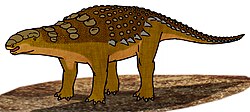 |
| Parasaurolophus | 1922 | Dinosaur Park Formation, Fruitland Formation, Kaiparowits Formation, Kirtland Formation (Late Cretaceous, Campanian) |  Canada Canada
( Alberta) Alberta)
 United States United States
( New Mexico New Mexico
 Utah) Utah) | Possessed a curved, hollow crest that varied in size between species | 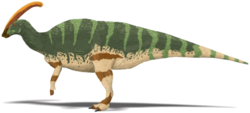 |
| Paraxenisaurus | 2020 | Cerro del Pueblo Formation (Late Cretaceous, Campanian) |  Mexico Mexico
( Coahuila) Coahuila) | Described as the first deinocheirid from North America |  |
| Parksosaurus | 1937 | Horseshoe Canyon Formation (Late Cretaceous, Maastrichtian) |  Canada Canada
( Alberta) Alberta) | Had long toes which may be an adaptation to walking on soft soils in watercourses and marshlands [67] |  |
| Paronychodon | 1876 | Hell Creek Formation, Judith River Formation, Lance Formation (Late Cretaceous, Campanian to Maastrichtian) |  United States United States
( Montana Montana
 North Dakota North Dakota
 South Dakota South Dakota
 Wyoming) Wyoming) | Only known from highly distinctive teeth |  |
| Pawpawsaurus | 1996 | Paw Paw Formation (Early Cretaceous, Albian) |  United States United States
( Texas) Texas) | Had enlarged nasal cavities that gave it an acute sense of smell, even more powerful than that of contemporary theropods [73] | 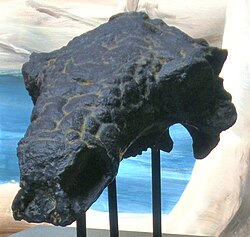 |
| Pectinodon | 1982 | Hell Creek Formation, Lance Formation (Late Cretaceous, Maastrichtian) |  United States United States
( Wyoming) Wyoming) | Had comb-like serrations on its teeth |  |
| Peloroplites | 2008 | Cedar Mountain Formation (Late Cretaceous, Cenomanian to Turonian) |  United States United States
( Utah) Utah) | One of the largest known nodosaurids |  |
| Pentaceratops | 1923 | Fruitland Formation, Kirtland Formation (Late Cretaceous, Campanian) |  United States United States
( New Mexico) New Mexico) | Its epijugal bones, the hornlets under its eyes, were relatively large | 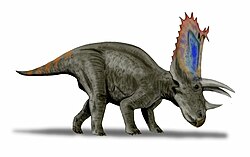 |
| Planicoxa | 2001 | Cedar Mountain Formation (Early Cretaceous, Barremian to Albian) |  United States United States
( Utah) Utah) | The rear of its ilium was characteristically flat |  |
| Platypelta | 2018 | Dinosaur Park Formation (Late Cretaceous, Campanian) |  Canada Canada
( Alberta) Alberta) | Originally assigned to Euoplocephalus but was given its own genus because of several morphological differences |  |
| Platytholus | 2023 | Hell Creek Formation (Late Cretaceous, Maastrichtian) |  United States United States
( Montana) Montana) | Differs from juveniles of the contemporary Pachycephalosaurus and Sphaerotholus , hence its classification as a new genus |  |
| Podokesaurus | 1911 | Portland Formation (Early Jurassic, Hettangian to Sinemurian) |  United States United States
( Massachusetts) Massachusetts) | May have had a tail one and a half times longer than the rest of its skeleton [74] |  |
| Polyodontosaurus | 1932 | Dinosaur Park Formation (Late Cretaceous, Campanian) |  Canada Canada
( Alberta) Alberta) | May be identical to Latenivenatrix [75] | |
| Polyonax | 1874 | Denver Formation (Late Cretaceous, Maastrichtian) |  United States United States
( Colorado) Colorado) | Poorly known | |
| Prenoceratops | 2004 | Oldman Formation, Two Medicine Formation (Late Cretaceous, Campanian) |  Canada Canada
( Alberta) Alberta)
 United States United States
( Montana) Montana) | The only basal neoceratopsian known from a bonebed |  |
| Priconodon | 1888 | Arundel Formation (Early Cretaceous, Aptian to Albian) |  United States United States
( Maryland) Maryland) | Large but only known from teeth |  |
| Probrachylophosaurus | 2015 | Foremost Formation, Judith River Formation (Late Cretaceous, Campanian) |  Canada Canada
( Alberta) Alberta)
 United States United States
( Montana) Montana) | Shows a skull morphology transitional between crestless and crested brachylophosaurins |  |
| Propanoplosaurus | 2011 | Patuxent Formation (Early Cretaceous, Aptian) |  United States United States
( Maryland) Maryland) | Only known from the imprints of a neonate skeleton |  |
| Prosaurolophus | 1916 | Dinosaur Park Formation, Two Medicine Formation (Late Cretaceous, Campanian) |  Canada Canada
( Alberta) Alberta)
 United States United States
( Montana) Montana) | Had a relatively large head for a hadrosaur |  |
| Protohadros | 1998 | Woodbine Formation (Late Cretaceous, Cenomanian) |  United States United States
( Texas) Texas) | Possessed a downturned jaw which may be an adaptation to grazing on low-growing plants | |
| Pteropelyx | 1889 | Judith River Formation (Late Cretaceous, Campanian) |  United States United States
( Montana) Montana) | Potentially synonymous with Corythosaurus , although this cannot be confirmed due to the lack of cranial remains [76] | |
| Rativates | 2016 | Dinosaur Park Formation (Late Cretaceous, Campanian) |  Canada Canada
( Alberta) Alberta) | Originally described as a specimen of Struthiomimus |  |
| Regaliceratops | 2015 | St. Mary River Formation (Late Cretaceous, Maastrichtian) |  Canada Canada
( Alberta) Alberta) | Possessed a series of large, pentagonal plates lining its frill | 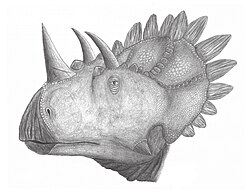 |
| Richardoestesia | 1990 | Aguja Formation, Dinosaur Park Formation, Ferris Formation?, Hell Creek Formation?, Horseshoe Canyon Formation?, Lance Formation?, Scollard Formation? (Late Cretaceous, Campanian to Maastrichtian?) |  Canada Canada
( Alberta) Alberta)
 United States United States
( Montana? Montana?
 Texas Texas
 Wyoming?) Wyoming?) | Teeth assigned to this genus have been recovered all around the world, in deposits spanning from the Jurassic to the Cretaceous, although they may not represent a single taxon |  |
| Rugocaudia | 2012 | Cloverly Formation (Early Cretaceous, Aptian to Albian) |  United States United States
( Montana) Montana) | Some of this genus' remains include several caudal vertebrae |  |
| Sarahsaurus | 2011 | Kayenta Formation (Early Jurassic, Sinemurian to Pliensbachian) |  United States United States
( Arizona) Arizona) | Possessed strong hands which may indicate a feeding specialization |  |
| Saurolophus | 1912 | Horseshoe Canyon Formation (Late Cretaceous, Maastrichtian) |  Canada Canada
( Alberta) Alberta) | Had a short, solid crest that pointed directly upwards. A larger, more well-known species has been found in Mongolia |  |
| Sauropelta | 1970 | Cedar Mountain Formation?, Cloverly Formation (Early Cretaceous, Albian) |  United States United States
( Montana Montana
 Utah? Utah?
 Wyoming) Wyoming) | Its tail had at least forty vertebrae, making up half of its total body length | 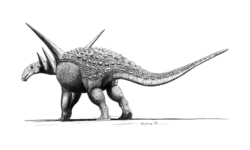 |
| Saurophaganax | 1995 | Morrison Formation (Late Jurassic, Kimmeridgian) |  United States United States
( New Mexico? New Mexico?
 Oklahoma) Oklahoma) | Originally described as a large theropod, but was later suggested to be a chimera of sauropod and theropod bones. The holotype bone may have belonged to a sauropod [77] |  |
| Sauroposeidon | 2000 | Antlers Formation, Cloverly Formation, Glen Rose Formation, Twin Mountains Formation (Early Cretaceous, Aptian to Albian) |  United States United States
( Oklahoma Oklahoma
 Texas Texas
 Wyoming) Wyoming) | Could raise its head up to 18 metres (59 ft) in the air, the height of a six-story building [78] | 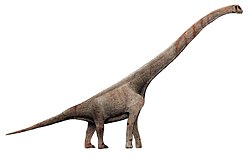 |
| Saurornitholestes | 1978 | Dinosaur Park Formation, Donoho Creek Formation, Kirtland Formation, Mooreville Chalk, Oldman Formation, Tar Heel/Coachman Formation, Two Medicine Formation (Late Cretaceous, Campanian to Maastrichtian) |  Canada Canada
( Alberta) Alberta)
 United States United States
( Alabama Alabama
 Montana Montana
 New Mexico New Mexico
 South Carolina) South Carolina) | Its second premaxillary teeth could be adapted to preening feathers [79] |  |
| Scolosaurus | 1928 | Dinosaur Park Formation, Oldman Formation (Late Cretaceous, Campanian) |  Canada Canada
( Alberta) Alberta) | Once widely believed to be synonymous with other Campanian ankylosaurids |  |
| Scutellosaurus | 1981 | Kayenta Formation (Early Jurassic, Sinemurian) |  United States United States
( Arizona) Arizona) | Had hundreds of osteoderms arranged in rows along its back and tail |  |
| Segisaurus | 1936 | Navajo Sandstone (Early Jurassic, Pliensbachian to Toarcian) |  United States United States
( Arizona) Arizona) | Preserves evidence of a wishbone similar to that of modern birds |  |
| Seitaad | 2010 | Navajo Sandstone (Early Jurassic, Pliensbachian) |  United States United States
( Utah) Utah) | The holotype may have died when a sand dune collapsed on it [80] |  |
| Siats | 2013 | Cedar Mountain Formation (Late Cretaceous, Cenomanian) |  United States United States
( Utah) Utah) | Large but inconsistent in phylogenetic placement |  |
| Sierraceratops | 2022 | Hall Lake Formation (Late Cretaceous, Campanian to Maastrichtian) |  United States United States
( New Mexico) New Mexico) | May be part of a unique clade of chasmosaurine ceratopsids only known from southern Laramidia [81] |  |
| Silvisaurus | 1960 | Dakota Formation (Early Cretaceous to Late Cretaceous, Albian to Cenomanian) |  United States United States
( Kansas) Kansas) | Hypothesized to live in a forested habitat |  |
| Smitanosaurus | 2020 | Morrison Formation (Late Jurassic, Oxfordian to Tithonian) |  United States United States
( Colorado) Colorado) | Only known from a partial skull and some vertebrae |  |
| Sonorasaurus | 1998 | Turney Ranch Formation (Early Cretaceous to Late Cretaceous, Albian to Cenomanian) |  United States United States
( Arizona) Arizona) | State dinosaur of Arizona |  |
| Sphaerotholus | 2002 | Dinosaur Park Formation, Frenchman Formation, Hell Creek Formation, Horseshoe Canyon Formation, Kirtland Formation (Late Cretaceous, Campanian to Maastrichtian) |  Canada Canada
( Alberta Alberta
 Saskatchewan) Saskatchewan)
 United States United States
( Montana Montana
 New Mexico) New Mexico) | Five species have been named, all known from skull elements. Lived in a broad range |  |
| Spiclypeus | 2016 | Judith River Formation (Late Cretaceous, Campanian) |  United States United States
( Montana) Montana) | Has been described as "boldly audacious" [82] |  |
| Spinops | 2011 | Dinosaur Park Formation?/Oldman Formation? (Late Cretaceous, Campanian) |  Canada Canada
( Alberta) Alberta) | Described almost a century after its remains were collected |  |
| Stegoceras | 1902 | Dinosaur Park Formation, Fruitland Formation?, Kirtland Formation?, Oldman Formation (Late Cretaceous, Campanian) |  Canada Canada
( Alberta) Alberta)
 United States United States
( New Mexico?) New Mexico?) | May have been an indiscriminate bulk-feeder due to the shape of its snout [83] |  |
| Stegopelta | 1905 | Frontier Formation (Early Cretaceous to Late Cretaceous, Albian to Cenomanian) |  United States United States
( Wyoming) Wyoming) | May have possessed a sacral shield similar to other nodosaurids | 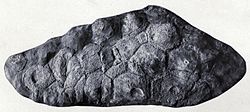 |
| Stegosaurus | 1877 | Morrison Formation (Late Jurassic, Kimmeridgian to Tithonian) |  United States United States
( Colorado Colorado
 Wyoming) Wyoming) | Had a single alternating row of large, kite-shaped plates |  |
| Stellasaurus | 2020 | Two Medicine Formation (Late Cretaceous, Campanian) |  United States United States
( Montana) Montana) | Possessed an enlarged, thickened nasal horn |  |
| Stenonychosaurus | 1932 | Dinosaur Park Formation, Two Medicine Formation? (Late Cretaceous, Campanian) |  Canada Canada
( Alberta) Alberta)
 United States United States
( Montana?) Montana?) | Its brain-to-body mass ratio is one of the highest of any non-avian dinosaur. Possibly synonymous with Troodon [84] |  |
| Stephanosaurus | 1914 | Dinosaur Park Formation (Late Cretaceous, Campanian) |  Canada Canada
( Alberta) Alberta) | Poorly known |  |
| Stokesosaurus | 1974 | Morrison Formation (Late Jurassic, Kimmeridgian? to Tithonian) |  United States United States
( South Dakota? South Dakota?
 Utah) Utah) | Only known from a few remains but they are enough to tell that it was a tyrannosauroid |  |
| Struthiomimus | 1917 | Horseshoe Canyon Formation?, Lance Formation?, Oldman Formation (Late Cretaceous, Campanian to Maastrichtian?) |  Canada Canada
( Alberta) Alberta)
 United States United States
( Wyoming?) Wyoming?) | Known from many specimens, indicating it was a common animal |  |
| Styracosaurus | 1913 | Dinosaur Park Formation, Two Medicine Formation? (Late Cretaceous, Campanian) |  Canada Canada
( Alberta) Alberta)
 United States United States
( Montana?) Montana?) | Possessed several long horns jutting out from the top of its frill, the patterns of which could have varied between individuals [85] | 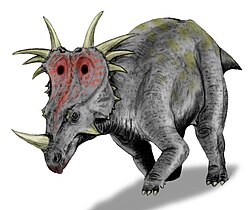 |
| Supersaurus | 1985 | Morrison Formation (Late Jurassic, Tithonian) |  United States United States
( Colorado Colorado
 Wyoming) Wyoming) | Several remains were originally believed to represent their own genera |  |
| Suskityrannus | 2019 | Moreno Hill Formation (Late Cretaceous, Turonian) |  United States United States
( New Mexico) New Mexico) | Small yet already possessed several features of larger, more derived tyrannosaurids, including an arctometatarsus |  |
| Suuwassea | 2004 | Morrison Formation (Late Jurassic, Oxfordian to Tithonian) |  United States United States
( Montana) Montana) | Shares features with both diplodocids and dicraeosaurids, but is most likely a member of the latter group [15] [51] |  |
| Talos | 2011 | Kaiparowits Formation (Late Cretaceous, Campanian) |  United States United States
( Utah) Utah) | The holotype specimen preserves a pathology on its sickle claw [86] | 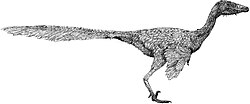 |
| Tanycolagreus | 2005 | Morrison Formation (Late Jurassic, Kimmeridgian to Tithonian) |  United States United States
( Colorado Colorado
 Utah Utah
 Wyoming) Wyoming) | Had a long, blunt snout |  |
| Tatankacephalus | 2009 | Cloverly Formation (Early Cretaceous, Aptian to Albian) |  United States United States
( Montana) Montana) | Retained premaxillary teeth in its upper jaws, a basal trait | |
| Tawa | 2009 | Chinle Formation (Late Triassic, Norian) |  United States United States
( New Mexico) New Mexico) | Well-preserved but inconsistent in phylogenetic placement |  |
| Tenontosaurus | 1970 | Antlers Formation, Arundel Formation, Cedar Mountain Formation, Cloverly Formation, Paluxy Formation, Twin Mountains Formation, Wayan Formation (Early Cretaceous, Aptian to Albian) |  United States United States
( Idaho Idaho
 Maryland Maryland
 Montana Montana
 Oklahoma Oklahoma
 Texas Texas
 Utah) Utah) | Remains of this genus are often found associated with skeletons of Deinonychus [87] |  |
| Teratophoneus | 2011 | Kaiparowits Formation (Late Cretaceous, Campanian) |  United States United States
( Utah) Utah) | Its snout was shorter and deeper than those of other tyrannosaurids |  |
| Terminocavus | 2020 | Kirtland Formation (Late Cretaceous, Campanian) |  United States United States
( New Mexico) New Mexico) | Had a teardrop-shaped hole on the top of its frill which was almost closed off by a pair of epoccipitals |  |
| Texacephale | 2010 | Aguja Formation (Late Cretaceous, Campanian) |  United States United States
( Texas) Texas) | Might represent a specimen of Stegoceras [88] |  |
| Texasetes | 1995 | Paw Paw Formation (Early Cretaceous, Albian) |  United States United States
( Texas) Texas) | Potentially synonymous with Pawpawsaurus |  |
| Thanatotheristes | 2020 | Foremost Formation (Late Cretaceous, Campanian) |  Canada Canada
( Alberta) Alberta) | A close relative of Daspletosaurus [89] |  |
| Theiophytalia | 2006 | Purgatoire Formation (Early Cretaceous, Aptian to Albian) |  United States United States
( Colorado) Colorado) | Only known from a skull originally referred to Camptosaurus |  |
| Thescelosaurus | 1913 | Frenchman Formation, Hell Creek Formation, Lance Formation, Laramie Formation, Scollard Formation (Late Cretaceous, Maastrichtian) |  Canada Canada
( Alberta Alberta
 Saskatchewan) Saskatchewan)
 United States United States
( Colorado Colorado
 Montana Montana
 North Dakota North Dakota
 South Dakota South Dakota
 Wyoming) Wyoming) | One specimen was originally considered to have preserved its heart, although this was later found to be a mineral concretion [90] |  |
| Thespesius | 1856 | Lance Formation (Late Cretaceous, Maastrichtian) |  United States United States
( South Dakota) South Dakota) | Once suggested to be a possible Miocene mammal |  |
| Tichosteus | 1877 | Morrison Formation (Late Jurassic, Kimmeridgian) |  United States United States
( Colorado) Colorado) | Two species have been named, both from isolated vertebrae |  |
| Titanoceratops | 2011 | Fruitland Formation?/Kirtland Formation? (Late Cretaceous, Campanian) |  United States United States
( New Mexico) New Mexico) | Potentially a large, old specimen of Pentaceratops [64] | 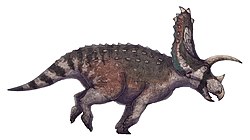 |
| Tlatolophus | 2021 | Cerro del Pueblo Formation (Late Cretaceous, Campanian) |  Mexico Mexico
( Coahuila) Coahuila) | Possessed a short, broad crest resembling an inverted comma | 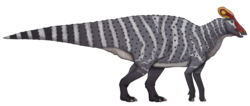 |
| Torosaurus | 1891 | Frenchman Formation, Hell Creek Formation, Lance Formation, North Horn Formation?, Scollard Formation (Late Cretaceous, Maastrichtian) |  Canada Canada
( Alberta Alberta
 Saskatchewan) Saskatchewan)
 United States United States
( Colorado? Colorado?
 Montana? Montana?
 New Mexico? New Mexico?
 North Dakota? North Dakota?
 South Dakota South Dakota
 Texas? Texas?
 Utah? Utah?
 Wyoming) Wyoming) | Once believed to be potentially synonymous with Triceratops |  |
| Torvosaurus | 1979 | Morrison Formation (Late Jurassic, Kimmeridgian to Tithonian) |  United States United States
( Colorado Colorado
 Wyoming) Wyoming) | Had short but powerfully built arms. Several species, many of them unnamed, have been found in Europe, South America and possibly Africa |  |
| Tototlmimus | 2016 | Packard Formation (Late Cretaceous, Campanian) |  Mexico Mexico
( Sonora) Sonora) | The southernmost ornithomimid known from North America | |
| Trachodon | 1856 | Judith River Formation (Late Cretaceous, Campanian) |  United States United States
( Montana) Montana) | Several remains assigned to this genus actually belong to other taxa, most notably Edmontosaurus |  |
| Triceratops | 1889 | Denver Formation, Evanston Formation, Hell Creek Formation, Lance Formation, Laramie Formation, Scollard Formation (Late Cretaceous, Maastrichtian) |  Canada Canada
( Alberta Alberta
 Saskatchewan?) Saskatchewan?)
 United States United States
( Colorado Colorado
 Montana Montana
 South Dakota South Dakota
 Wyoming) Wyoming) | A common ceratopsid with long brow horns and a short nasal horn |  |
| Trierarchuncus | 2020 | Hell Creek Formation (Late Cretaceous, Maastrichtian) |  United States United States
( Montana) Montana) | Known from remains of different sizes which depict how the claws of alvarezsaurids grew more hooked as they aged |  |
| Troodon | 1856 | Judith River Formation, Two Medicine Formation? (Late Cretaceous, Campanian) |  United States United States
( Montana) Montana) | Usually seen as a dubious, undiagnostic genus, but a later study recommends the formal designation of a neotype to preserve its validity based on new troodontid fossil material discovered in the Two Medicine Formation [84] |  |
| Tyrannosaurus | 1905 | Frenchman Formation, Hall Lake Formation, Hell Creek Formation, Lance Formation, North Horn Formation, Scollard Formation, Willow Creek Formation (Late Cretaceous, Campanian to Maastrichtian) |  Canada Canada
( Alberta Alberta
 Saskatchewan) Saskatchewan)
 United States United States
( Colorado Colorado
 Montana Montana
 New Mexico New Mexico
 South Dakota South Dakota
 Utah Utah
 Wyoming) Wyoming) | The last, largest and most well-known tyrannosaurid |  |
| Unescoceratops | 2012 | Dinosaur Park Formation (Late Cretaceous, Campanian) |  Canada Canada
( Alberta) Alberta) | Had the roundest teeth of any known leptoceratopsid | |
| Utahceratops | 2010 | Kaiparowits Formation (Late Cretaceous, Campanian) |  United States United States
( Utah) Utah) | Almost the entire skeleton is known, including the skull |  |
| Utahraptor | 1993 | Cedar Mountain Formation (Early Cretaceous, Berriasian to Valanginian) |  United States United States
( Utah) Utah) | Very large and powerfully built |  |
| Uteodon | 2011 | Morrison Formation (Late Jurassic, Tithonian) |  United States United States
( Utah) Utah) | May be a species of Camptosaurus , with a referred braincase being from Dryosaurus [91] |  |
| Utetitan | 2025 | Black Peaks Formation?, Javelina Formation?, North Horn Formation (Late Cretaceous, Maastrichtian) |  United States United States
( Texas? Texas?
 Utah) Utah) | Known from partial skeletons originally identified as possible northern specimens of Alamosaurus |  |
| Vagaceratops | 2010 | Dinosaur Park Formation (Late Cretaceous, Campanian) |  Canada Canada
( Alberta) Alberta) | Possessed a row of fused epoccipitals folding over the top of the frill |  |
| Velafrons | 2007 | Cerro del Pueblo Formation (Late Cretaceous, Campanian) |  Mexico Mexico
( Coahuila) Coahuila) | May have had elongated neural spines similar to those of Hypacrosaurus altispinus |  |
| Venenosaurus | 2001 | Cedar Mountain Formation (Early Cretaceous, Aptian to Albian) |  United States United States
( Utah) Utah) | Its skeleton has traits of both titanosaurs and more basal macronarians | |
| Wendiceratops | 2015 | Oldman Formation (Late Cretaceous, Campanian) |  Canada Canada
( Alberta) Alberta) | Had three pairs of enlarged, curved epiparietals at the very top of its frill |  |
| Xenoceratops | 2012 | Foremost Formation (Late Cretaceous, Campanian) |  Canada Canada
( Alberta) Alberta) | Possessed two long spikes at the top of its frill with smaller knobs at their bases |  |
| Yehuecauhceratops | 2017 | Aguja Formation (Late Cretaceous, Campanian) |  Mexico Mexico
( Coahuila) Coahuila) | One of the smallest known ceratopsids |  |
| Yurgovuchia | 2012 | Cedar Mountain Formation (Early Cretaceous, Valanginian) |  United States United States
( Utah) Utah) | May have had a flexible tail due to the structure of its caudal vertebrae |  |
| Zapsalis | 1876 | Judith River Formation (Late Cretaceous, Campanian) |  United States United States
( Montana) Montana) | Some teeth referred to this genus actually belong to Saurornitholestes [79] |  |
| Zephyrosaurus | 1980 | Cloverly Formation (Early Cretaceous, Aptian to Albian) |  United States United States
( Montana) Montana) | Currently only known from fragmentary remains but several undescribed specimens exist [92] |  |
| Ziapelta | 2014 | Kirtland Formation (Late Cretaceous, Campanian) |  United States United States
( New Mexico) New Mexico) | Many specimens are known, most from the front part of the animal |  |
| Zuniceratops | 1998 | Moreno Hill Formation (Late Cretaceous, Turonian to Coniacian) |  United States United States
( New Mexico) New Mexico) | Carried a pair of brow horns despite not being a member of the Ceratopsidae |  |
| Zuul | 2017 | Judith River Formation (Late Cretaceous, Campanian) |  United States United States
( Montana) Montana) | Preserves several osteoderms, keratin and skin remains | 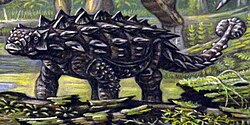 |
























































































































































































































































































































